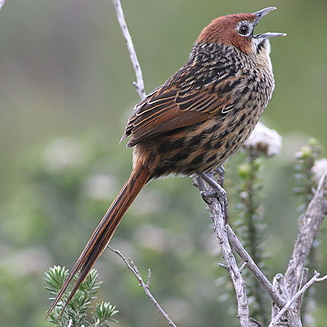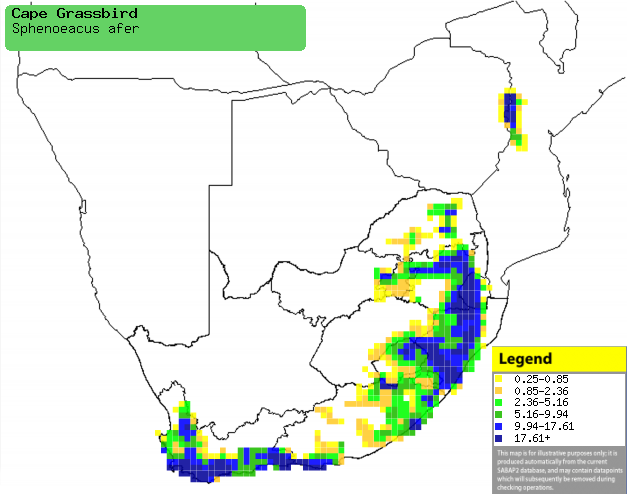|
Sphenoeacus afer (Cape
grassbird)
Grasvoël [Afrikaans]; Itshitshi, Udwetya [Xhosa];
Kaapse grasvogel [Dutch]; Sphénoèque du Cap [French]; Kap-grassänger
[German]; Felosa do Cabo [Portuguese]
Life
> Eukaryotes >
Opisthokonta
> Metazoa (animals) >
Bilateria >
Deuterostomia > Chordata >
Craniata > Vertebrata (vertebrates) > Gnathostomata (jawed
vertebrates) > Teleostomi (teleost fish) > Osteichthyes (bony fish) > Class:
Sarcopterygii (lobe-finned
fish) > Stegocephalia (terrestrial
vertebrates) > Tetrapoda
(four-legged vertebrates) > Reptiliomorpha > Amniota >
Reptilia (reptiles) >
Romeriida > Diapsida > Archosauromorpha > Archosauria >
Dinosauria
(dinosaurs) > Saurischia > Theropoda (bipedal predatory dinosaurs) >
Coelurosauria > Maniraptora > Aves
(birds) > Order: Passeriformes
> Family: Sylviidae
 |
 |
|
Cape grassbird, Kleinmond, Western Cape, South
Africa. [photo
Duncan Robertson ©] |
Cape grassbird, Harold Porter Botanical Gardens,
South Africa. [photo Trevor Hardaker ©] |
Distribution and habitat
Endemic to southern Africa, with the bulk of its population
in the Western Cape, Eastern Cape, KwaZulu-Natal, Lesotho, Swaziland and Lempopo
Province; it also occurs in Zimbabwe’s eastern highlands. It generally prefers
habitats with restios, rank grasses or ferns, such as fynbos and grassland. It
also occupies montane forest edges with Bracken (Pteridium aqualinum) and Brier
(Smilax anceps).
|
 |
|
Distribution of Cape grassbird in southern Africa,
based on statistical smoothing of the records from first SA Bird Atlas
Project (©
Animal Demography unit, University of
Cape Town; smoothing by Birgit Erni and Francesca Little). Colours range
from dark blue (most common) through to yellow (least common).
See here for the latest distribution
from the SABAP2. |
Food
It mainly eats insects, such as beetles, grasshoppers and
caterpillars, doing most of its foraging on the ground beneath vegetation.
Breeding
- The female builds the nest, which is a bowl built of twigs, grass blades,
leaves, lined with finer plant material. It is typically concealed near the
ground in a tussock of grass or Restio, or just in some tangled vegetation.
- Egg-laying season is from about July-December in the Western Cape,
elsewhere it is from roughly October-April, peaking from October-December.
- It lays 2-3 eggs, which are incubated solely by the female for
approximately 14-18 days.
- The chicks are fed by both adults, leaving the nest after about 14-16
days.
Threats
Not threatened.
References
-
Hockey PAR, Dean WRJ and Ryan PG 2005. Roberts
- Birds of southern Africa, VIIth ed. The Trustees of the John Voelcker
Bird Book Fund, Cape Town.
|
